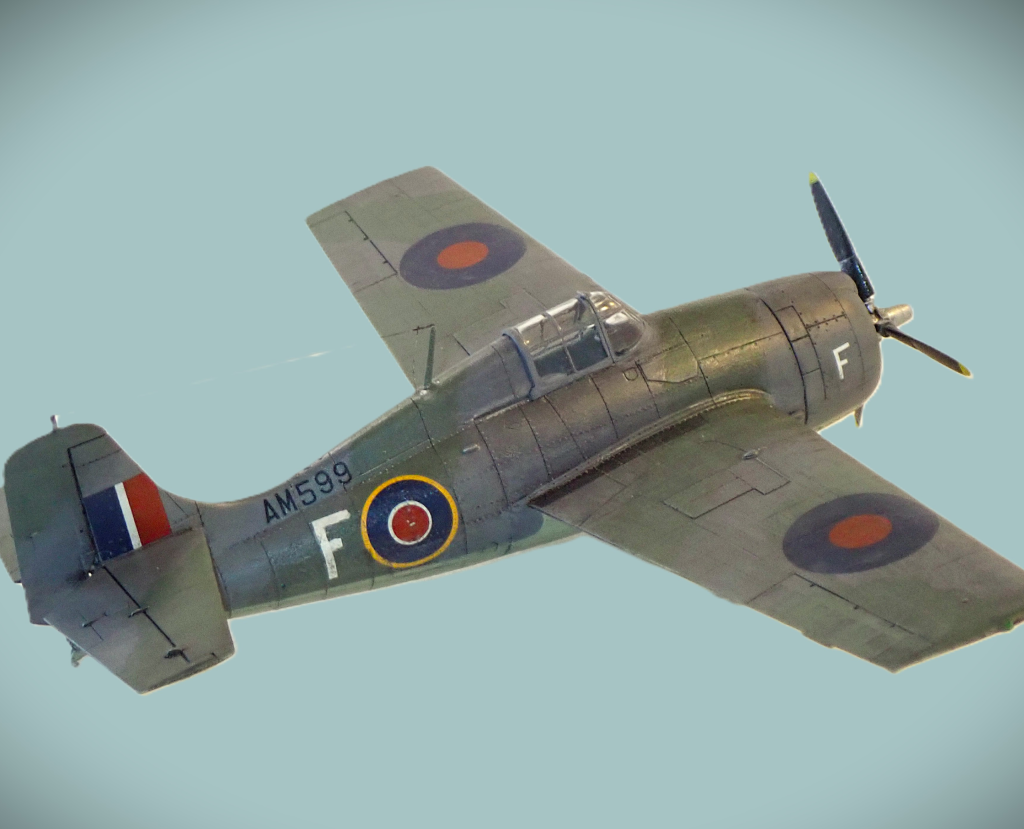The first of the American aircraft to operate with the FAA and RAF was the Grumman Wildcat. However, it was by accident that Britain acquired this type.
The Grumman Wildcat is a single engine carrier-borne single seat cantilever wing fighter originally designed the F4F by Grumman specifically for carrier use. The type is small, compact, fast for its time and heavily armed, powered by a Pratt & Whitney radial engine. It was the second monoplane type to be used by the FAA on Royal Navy Carriers, the first being the Sea Hurricane on HMS Furious in July 1941
In 1939 France put an order in for 81 Wildcats with Belgium placing an order for 10. These were an export version of the F4F-3, the G-36A. With the fall of both countries in May 1940 , the delivery of the Wildcat was diverted to Britain for use with the FAA. 10 of the aircraft were lost on route to the UK when the transport ship was sunk, but 81 arrived in July 1940. The FAA renamed the aircraft the Martlet so these 81 aircraft entered service in September 1940 as the Martlet I. Renaming of American aircraft became the norm, as did modifying to suite British specifications, as we shall see.
After test flights and assessment there were certain aspects which were deemed unsuitable, including fixed wing, but many of the test pilots were quite excited about the little plane. Therefore, the early Martlet I was limited to land-based operations and for training purposes. The Martlet I entered service in September 1940 in the Orkney Islands with 804 Squadron FAA at Royal Naval Base Hartston. It was here that the first kill by an American aircraft of the FAA was achieved when two Martlet I‘s brought down a Junkers Ju 88 over Scapa Flow.
The FAA placed an order for 100 Wildcat G-36B in 1940 with specifications for an FAA version, named the Martlet II. The Royal Navy required folding wings and three .5 Browning per wing. The first ten to be delivered were without folding wings but were delivered anyway as part of the first batch in March 1941. (These ten were redesignated Martlet III). The Martlet II order was then delayed to fulfil the requirements of a more advanced Grumman Sto-Wing folding wing system. The first of these was delivered in August 1941. They were used straight away with the majority being sent to the Far East. However, to prove the validity of the Light Fleet Carrier, six were dispatched on HMS Audacity in the Mediterranean in September 1941. The Martlet IIs remained on deck as the vessel had no lifts. The first mission escorted a convoy to Gibraltar and the Martlets shot down an Fw 200. Further missions also proved that fighter cover was useful against U-Boats. Five more Fw 200 were destroyed during subsequent ops until the Audacity was sunk by U-Boat attack in December 1941, but the concept had proved its worth.
The next production model was the Martlet III. 30 of these had been ordered by Greece as a fixed wing, four-gun version. After Greece fell the Martlets had only reached Gibraltar and were reissued to the FAA. The 30 aircraft were used solely in the North Africa campaign for land-based operations and painted an overall sand colour.
Britain had placed an order for 220 Martlet IV, the F4F-4 but with British design specs adapted including folding wings, self-sealing fuel tanks and the Wright R-1830 Cyclone 2-stage supercharged engine with the larger cowling. The heavy three gun per wing configuration was included. These were the first aircraft to be acquired under the new Lend Lease Act of 1942. All 220 were delivered by November 1942. The Martlet IV was used to great effect during Operation Torch and the Sicily Invasion as well as Mediterranean operations throughout 1942 and 1943. HMS Victorious carried 882 NAS and HMS Formidable carried 893 NAS.
The Martlet V was the next version which was based on the Wildcat FM-1 in 1943. 312 were ordered by the Fleet Air Arm, mainly to serve aboard the increasing number of Light Carriers escorting convoys in the Atlantic, Pacific and Indian Oceans. The short runway deck suited the stocky little aircraft. This version was renamed Wildcat V by the Royal Navy to avoid confusion with increasing number of aircraft types.
The final, and best version was the Wildcat VI in late 1944 and 1945. Basically, an FM-2 with British specs installed and the standardised two .5 Browning per wing with provision to carry 500 lb bombs. 320 of these were delivered to the FAA.
In total the FAA used 1200 Wildcats from the Martlet variants to the Wildcat V and VI. The type was withdrawn from service when the war finished as they had progressively become more outclassed during 1944 and 45. The Wildcat VI of the FAA were to take part in the last air raid of the European theatre in May 1945 on the Norwegian Coast downing six Bf 109’s in the process.
There are numerous Wildcat survivors in America, none of which are FAA versions, but only two Martlets in the UK, of which one is airworthy.
FM-2 Wildcat VI 86690 restored by the Aircraft Restoration Company at IWM, Duxford. Crashed in 2023 and undergoing repairs.
FM-2 Wildcat VI 86711 with The Fighter Collection in IWM, Duxford.
Martlet I F4F-3 AL246 on static display at the FAA Museum, Yeovilton.
